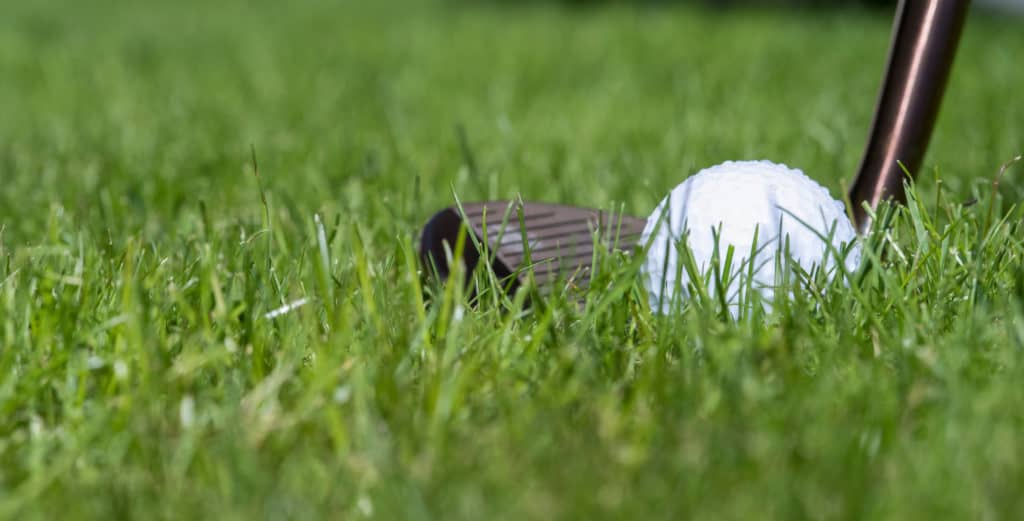There are several keys we would recommend to help you experience success:
- Read the lie
- Determine the shot you would like to play
- Use plenty of loft
- Stay patient through the shot
- Create a margin of error to maximize success
One of the greatest, but most difficult elements of the game of golf is the different lies and types of grass you are faced with from round to round.
If you are someone that plays a variety of golf courses, you must be able to adjust to the different types of situations you are going to be faced with.
If you played 10 different golf courses in a season, you could be faced with a tight lie like a golfer might face at Augusta National to the lies you would face at the most difficult US Open style rough. And then of course, everything in between.
So, how can a golfer get ready? The first step is knowledge, experimentation and then pracitce to find your system for the variety of lies you might face.
For today, we are going to give a complete overview on chipping from the rough.
Chipping From The Rough
My Journey: I actually prefer to chip from the rough. It provides an extra layer of to allow the golfer to get more loft without fear of chunking or blading the shot. The most difficult part of chipping from the rough is the lack of spin and uncertainty on how clean you are going to catch the ball. Practice a variety of lies and try to build some experience of how far the ball will fly and how to use loft to help the ball stop quickly.

Key #1: Read the Lie
There are several things to check out as your get to your golf ball:
- How thick is the rough?
- Is your ball sitting down in the rough?
- Is there a clump of grass behind the ball?
I would highly recommend practicing from different types of lies to build your skill with hitting a variety of situational shots. The more confidence you can build, the better you will execute when faced with a shot like this. During your practice chipping time, throw golf balls to random spots and hit them as they lie.
Practice reading the lie and make a prediction of how the ball will exit the lie with different clubs that you might chip with.
Key #2: Determine the shot you would like to play
There are several things to consider?
- Is there a forced carry due to a bunker or other hazard?
- How much green do you have to work with?
- How far do you want to carry the shot?
- What shot would eliminate the big number while still giving you a chance to save par?
The golfer will want to understand the situation in the round he or she is playing. If you are playing match play, you might take a riskier shot based on where your opponent currently is. I have found that the more rough, the more loft you should use without getting carried away. The ball can often come out higher and softer with more loft.

Key #3: Use plenty of loft
Oftentimes a decent amount of loft can cause lower lofted wedges to turn down and cause mishits through the hitting zone. I prefer to use enough loft to allow you to take a longer, yet patient swing that sends the ball higher and softer onto the green. Once again, experiment with different lies and different clubs to find your system.
With today’s firm and fast greens with big bunkering built into many golf courses, carrying a 58 or 60 degree lob wedge is highly recommended for a higher percentage of golfers regardless of current handicap level. Greens are faster and more difficult as ever, give yourself a chance with the right equipment!
Key #4: Stay patient through the shot
What you might find is that chipping from the rough can be easier than chipping from a tie lie. In many cases there is a larger margin for error that allows the golfer to hit a soft, delicate shot to where they need it to go without fear of the bladed or chunked shot.
With the extra rough, the ball is often sitting slightly off the ground, providing more room for error. Stay patient and keep a consistent tempo through the shot.

Key #5: Create a margin of error to maximize success
Don’t try to play the miracle shot. You have found yourself potentially in a difficult position, adjust and adapt and be sure to walk away with at most a bogey, but give yourself a chance to sink the par putt, even if it is a 20 foot par putt.
The extra rough and the extra loft can help you ensure you are going to hit the ball and get the ball on your green. Just be careful of how close you come to bunker edges or other situations that turn a bogey into a double or triple bogey.
What club should I chip with from the rough?
I would recommend a 56 degree sand wedge or a 60 degree lob wedge. Both provide plenty of loft and the ability to hit the ball high enough and soft enough to help it stop close to the hole. If you have a longer chip shot with plenty of green, you might consider a 52 degree gap wedge.
Chipping from the Rough: Practice Routine
Too many golfers never practicing chipping, but remained shocked that they can’t chip. Practicing chipping is one of the quickest ways to improve your overall score. Very few golfers hit 15 or more greens in regulation and many amateurs will mist more than 9.
This leaves most golfers hitting chip shots on 4-14 holes per round. What if you could get up and down even 40% of the time you miss a green in regulation?
Next Steps: Create A Chipping System From The Rough
The next step is to pick your system to control your distance. Some will play completely by feel, while others will use a clock like system to control the length of the swing, the club used and then decide on the speed of the swing.
There are three variables that impact the distance a ball will travel when chipping:
- The loft of the club
- The length of the swing
- The speed of the swing
The shot that has the least amount of loft, with the longest, fastest swing will travel the furthest.
The slowest swing, that is the shortest with the most amount of loft will travel the shortest.
Recommended System
After determining the landing spot of the shot and determining how the shot will roll out, the golfer should decide on three different options.
The golfer will first decide on the club to use, the length of the swing, and the speed. The golfer should take into consideration the lie and how they are feeling at the time.
- The golfer can pick anywhere from a 6 iron to a lob wedge.
- The next step is to determine the length, 7:00, 8:00 and 9:00 (shortest to longest)
- The speed of the swing (slow, medium, and fast)
The clock system assumes the club is pointed at 6:00 at address. For the shortest swing, the golfer would take the club to 7:00, medium length would be 8:00 and the longest swing would be 9:00. 12:00 is by your head, and 6:00 is by your feet.
The speed of the swing is slow, medium and fast. This is pretty self explanatory, but the golfer should stay smooth with whatever speed is selected.
For example if the golfer has a chip shot of 30 feet. The golfer might select the sand wedge, an 8:00 swing at a medium speed. Or the golfer might go with a 9 iron, a 7:00 swing, with a fast swing and keep it nice and simple. The golfer has options and should practice the different options to determine what is best in each situation faced on a course.

Final Thoughts: Keep It Fun!
Keep your practice fun and work in some competition. Here is my favorite go to game, where you are by yourself or with a friend:
- Take one golf ball and throw it to a random spot off the green.
- Pick one hole for that shot and try to chip it as close as possible.
- Now, grab your putter and try to make the putt.
- Do this 18 times and track your number of successful attempts out of 18.
- Repeat this daily or weekly and monitor your progress
What is the quality of your chips? How often were you able to chip it inside of 3 feet, and 10 feet. Track this data as well over time to see if you are making progress. Of course, you should throw the golf to a variety of lies to help you adjust and adapt while on the golf course.
Other Chipping Related Posts:
- Alternative chipping techniques
- Chipping with a lob wedge
- Chipping vs putting
- How to stop blading chip shots
- How to stop chunking chip shots
- 11 golf drills for chipping
My Secret To Golf Improvement
Let’s face it, in order to get really good at golf, we must practice frequently. About three years ago, I made the leap and invested in a golf simulator build for my garage. I went with a SkyTrak Launch Monitor and the TGC software and can now play over 100,000 courses including Augusta, Pebble Beach, Bethpage Black, Whistling Straits. St. Andrews and many other of the top 100 courses in the world.
This golf simulator setup, which is more affordable that you might imagine, has been a game changer. I can now play golf everyday of the year regardless of rain, snow, cold weather or time of day. I can practice or play rounds of golf. I can stand in the 11th fairway at Augusta and with the auto-rewind feature I am able to practice my approach shots from various differences.
It is worth checking out through Rain or Shine Golf as they offer some incredible packages along with financing offers that are difficult to beat.
Some direct links to Rain or Shine Golf for pricing and financing:
Take Action – What You Can Do Today to Get Better
What does this mean for you? I believe in the following recipe to get better:
1 – Improve your motion in the golf swing by identifying a golf instructor. Here are some options:
Here is a list of golf instructors that we have reviewed:
2 – Train to swing faster and improve your swing speed. Here are some options:
Looking to gain more Speed and Distance in your swing. Two Options:
3 – Understand course strategy and work to break through your next barrier. Here is a series on breaking through:
We have provided guides on how to break 100, 90, 80 and 70. Check out more below, if interested.
4 – Practice Frequently
Did you know that I build a golf simulator in my garage and have played over 500 rounds of golf on my SkyTrak system? It has been a game changer and one worth checking out. Here are some of my other posts on golf simulators frequently asked questions:
- Is a Golf Simulator Worth It?
- How to Build a Golf Simulator?
- What is the Best Golf Simulator?
- Golf Simulator Accessories?
- How to Build a Golf Simulator for under $7000
- Top 11 Reasons to Buy a SkyTrak
- How to Build a Golf Simulator for Under $1000
- Why Build A Golf Simulator?
- What Space is Needed?
- Can A Golf Simulator Improve My Game?
- How Much Does A Golf Simulator Cost?
- Don’t Forget to Check out our 15 best golf swings of all time.
I am an amateur golfer on a journey to get better, enjoy the game as often as possible and share my passion and knowledge with others. I have coached high school golfers at a high level and have a great passion for the game and want to give back. I enjoy learning about the golf swing and am currently studying to be a certified professional golf instructor. Join me in our journey to get better everyday.

